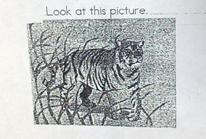behavioral adaptation
the colorings or patterns on an animals body that allow it to blend in with its environment
camouflage
the second, worm like, stage in an insect’s life cycle
larva
a life cycle where an insect hatches from an egg and then goes through several nymphal stages
incomplete metamorphosis
what gives animals the energy they need to survive
A climate
B space
C food
D shelter
c food
the movement of groups of organisms from one place to another, usually when the seasons change
migration
An animal with thick fur most likely within a place that is
cold
the living thing made when an animal reproduces
offspring
a single member of a species
individual
what is true of adult frogs?
a They live only in water.
b. They have tails.
c. They give birth to live young.
d They breathe with lungs not gills.
d
a behavior or body part that helps a living thing survive in its environment
adaptation
how do a tiger's stripes help it?

blend in or camouflage
the series of changes that a living thing goes through during its lifetime
life cycle
the first stage in most all insect life cycles
egg
What is the first stage of a bird's life cycle?
egg
to reduce the body movement during winter in an effort to conserve energy
hibernate
Which is an example of a behavior that is an adaptation for getting food?
The markings on a giraffe
A spider spinning a web
The thick fur of a polar bear
The spines of a cactus
a spider
a process of physical changes that some organisms go through that consists of 4 stages- egg, larva, pupa, adult
complete metamorphosis
molting allows insects to
A eat
B fly
C reproduce
D grow
D grow
How do baby mammals get the energy they need?
A. They find food on their own.
B. They drink milk from their mothers.
C They use energy form the sun.
D. The mother feeds them her food.
b milk
physical features of an organism like the bill on a bird or the fur on a bear
structural adaptation
Which of the following is NOT a reason an organism has adaptations.
Self-defense
to get food
to survive harsh conditions
to breathe
to breathe
the third stage of an insect’s life cycle, during which it changes into an adult
pupa
name one way a baby frog is different than an adult frog
tadpoles have tails- adult have 4 legs
tadpoles swim in water- adults can live on land and water
tadpoles breathe with gills- adult breath with lungs
This animal will develop into an adult
A fish
b frog
c butterfly
d bird
b